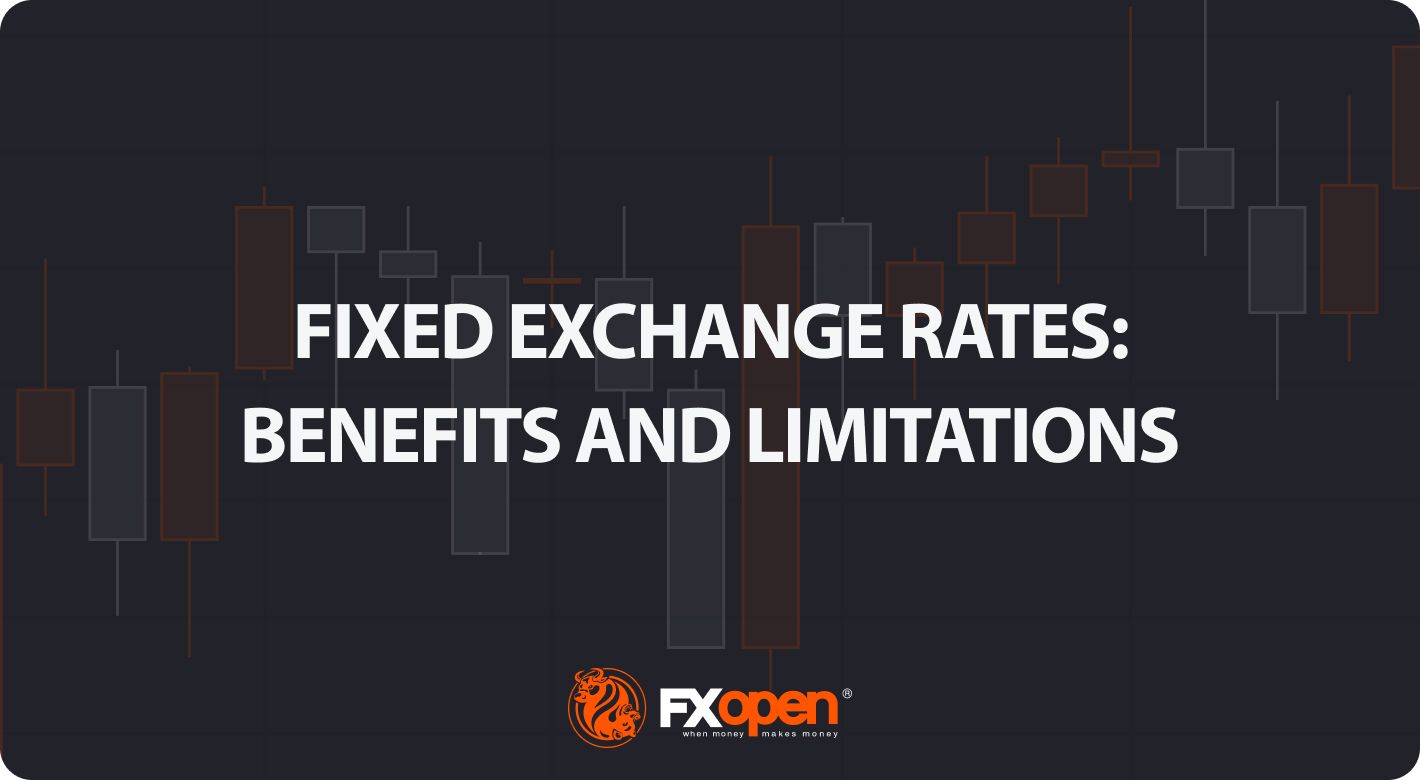FXOpen

Fixed exchange rates, a cornerstone of international finance, play a pivotal role in shaping global commerce and investment landscapes. This article delves into their intricacies, exploring the historical evolution, practical understanding, and the balance of benefits and challenges they present.
Historical Context of Fixed Exchange Rates
The concept of a fixed exchange rate system dates back centuries, but its modern incarnation emerged prominently with the Bretton Woods agreement in 1944. This fixed exchange rate regime established stable currency rates by pegging them to the US dollar (USD), which was convertible to gold.
This arrangement aimed to provide international monetary stability by preventing competitive devaluations and promoting economic growth. However, by the early 1970s, the Bretton Woods system collapsed, leading to a shift towards more flexible currency systems. Despite this, pegged exchange rates continue to be adopted in various forms by several countries.
Understanding Fixed Exchange Rates
A fixed exchange rate is a system where a country's currency value is tied to another major currency or a basket of currencies. In this regime, the exchange rate is maintained within a very narrow range. Countries with fixed exchange rates adopt this approach to stabilise global trade and financial relations.
A real-world fixed exchange rate example is the Hong Kong dollar (HKD), which has been pegged to the US dollar since 1983. Under this arrangement, the Hong Kong dollar is maintained at a fixed value of approximately 7.8 to the US dollar. This stability is achieved by the Hong Kong Monetary Authority, which trades the local currency against the USD as needed. You can see how this relationship has unfolded throughout the years with USD/HKD charts in FXOpen’s free TickTrader platform.
The predictability offered by a stable rate is typically advantageous for international trade and investment, but it requires significant reserves of the pegged currency to maintain its value.
Fixed Exchange Rate Pros and Cons
While many economies choose a floating system nowadays, there are pros and cons of a fixed exchange rate.
Advantages of a Fixed Exchange Rate
- Stability in Global Trade: Pegged currencies reduce the uncertainty and risk associated with floating currencies, making it easier for businesses to plan and engage in international commerce.
- Reduced Risk in International Investments: Investors are more likely to invest in countries with stable currencies, as it lowers the risk of losing money through price fluctuations.
- Control of Inflation Rates: Countries can maintain low inflation levels by pegging their currency to a stable, low-inflation economy.
- Prevent Competitive Devaluations: Such a regime prevents countries from engaging in competitive devaluations, which may lead to a 'race to the bottom' and global economic instability.
- Increased Policy Discipline: Anchored rates can impose discipline on a country's fiscal and monetary policies, as maintaining the peg requires consistent, responsible economic management.
- Simplified Transactions: A fixed currency simplifies the process of global transactions by providing predictability in exchange costs, reducing the need for complex hedging strategies.
Disadvantages of a Fixed Exchange Rate
- Overvaluation or Undervaluation: Maintaining a fixed rate might lead to misalignment, where a currency may become overvalued or undervalued relative to its economic fundamentals.
- High Costs of Maintenance: To maintain the peg, countries often need to hold large reserves of foreign currency, which may be costly and economically inefficient.
- Lack of Monetary Policy Flexibility: Countries lose the ability to set their own interest rates and conduct independent monetary policy, as they must focus on maintaining the peg.
- Vulnerability to External Shocks: Tied exchange rates can make a country more susceptible to economic problems in the nation to which its currency is pegged.
- Risk of Speculative Attacks: If investors believe a currency is overvalued or undervalued, they may engage in speculative attacks, leading to severe financial crises.
- Reduced Responsiveness to Domestic Conditions: A pegged currency regime limits a country’s ability to respond to domestic economic changes, such as inflation, unemployment, or economic downturns.
Fixed Exchange Rates in Modern Trading
In modern trading, understanding the dynamics of fixed currencies offers traders specific advantages and insights:
- Predictability in Forex Pairs: Traders can anticipate less volatility in forex involving a fixed value, allowing for more stable long-term investment strategies.
- Indicator of Economic Policies: The status and changes in a fixed rate potentially signal shifts in a country's monetary and fiscal policies, providing traders with crucial information for decision-making.
- Trade and Investment Decisions: Understanding which countries have pegged rates can guide traders in making informed decisions about trade and investment opportunities.
List of Fixed Exchange Rate Currencies
As of 2023, several currencies operate under a fixed exchange rate system. Notable examples include:
- Hong Kong dollar (HKD) - pegged to the US dollar.
- United Arab Emirates dirham (AED) - pegged to the US dollar.
- West African CFA franc (XOF) and Central African CFA franc (XAF) - both pegged to the euro.
- Bahamian dollar (BSD) - pegged to the US dollar.
- Danish krone - pegged to the euro.
The Bottom Line
In conclusion, grasping the nuances of fixed exchange rates is crucial for anyone involved in international finance. Whether weighing the pros and cons or observing their impact on modern trading, this knowledge is invaluable. For those looking to apply this understanding practically, opening an FXOpen account can be a strategic step, offering a platform to navigate and capitalise on the opportunities in the global financial markets.
This article represents the opinion of the Companies operating under the FXOpen brand only. It is not to be construed as an offer, solicitation, or recommendation with respect to products and services provided by the Companies operating under the FXOpen brand, nor is it to be considered financial advice.
Stay ahead of the market!
Subscribe now to our mailing list and receive the latest market news and insights delivered directly to your inbox.








